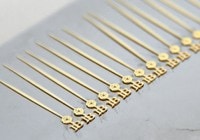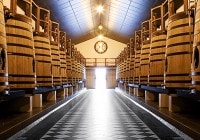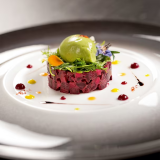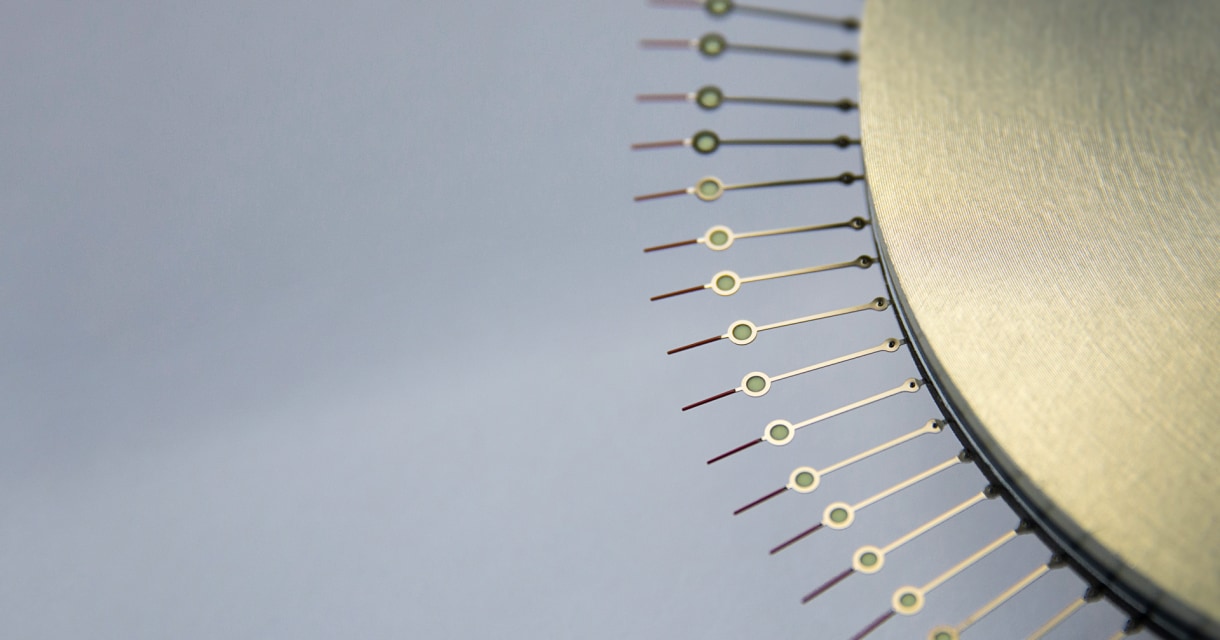
Search in Issues
Chapters
List of parts
Chapter 5
JOËL ROBUCHON
The most celebrated chef of our time.
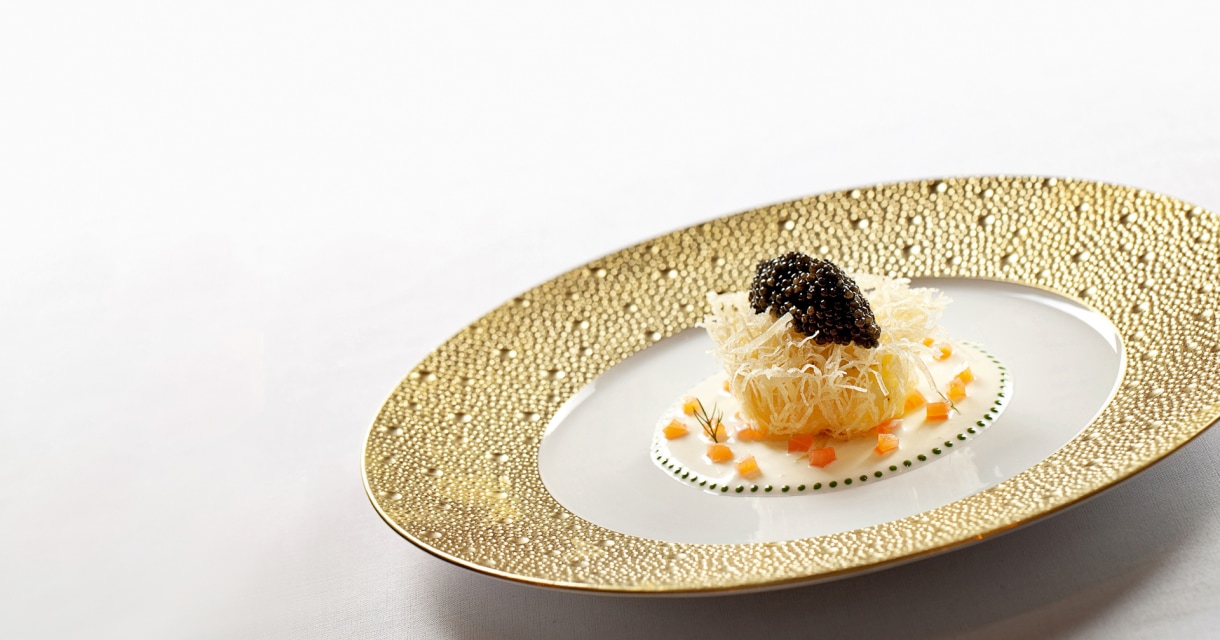
The Michelin verdict: 25 STARS and counting!
Is it possible in an authoritative creditable way to nominate one chef as the most acclaimed in the world? Banish all thoughts of reference to the preposterous and amateurish list hawked by a sparkling water company of the “World’s 50 Best Restaurants”, for it is a survey that does not even verify, much less require, that the nonprofessional voters in its compilation have actually eaten at the establishments being rated. Look instead to the Guide Michelin and Gault&Millau. Michelin, which has been at it since 1900, with its star rating system dating from 1926, and with a rigor prized by its readers and feared by restaurateurs, justifiably has no peer. For the top restaurants, those which would vie for the prized crown of three stars, inspectors visit anonymously and multiple times each year. As a testament to its integrity and impartiality, Michelin, in the forming of its yearly judgments, famously proclaims, “ni piston, ni pot-de-vin”, which translates to immunity from both pressure and bribes. Gault&Millau’s inspection system does not boast the famous secrecy of the Michelin clandestine visits. Nonetheless, its reviewers are both thoroughly professional and experienced. Both of these authoritative institutions have coalesced in their opinions around a single person as the most important cuisinier in the world. From the Guide Michelin, a total of 25 Michelin stars have been bestowed upon his restaurants around the globe (and the newest restaurant in Bordeaux has opened too recently to have been awarded stars by Michelin), vastly more than any other chef. Looking at Gault&Millau, he has received both the highest number of points that Gault&Millau awards in France, 19 out of 20 (and previously 19.5 out of 20, before the decision was made to limit the top possible score to 19), and been awarded the title of “Cuisinier of the Century”. Taking these distinctions together, the name of Joël Robuchon clearly emerges as the most honored chef of our time.
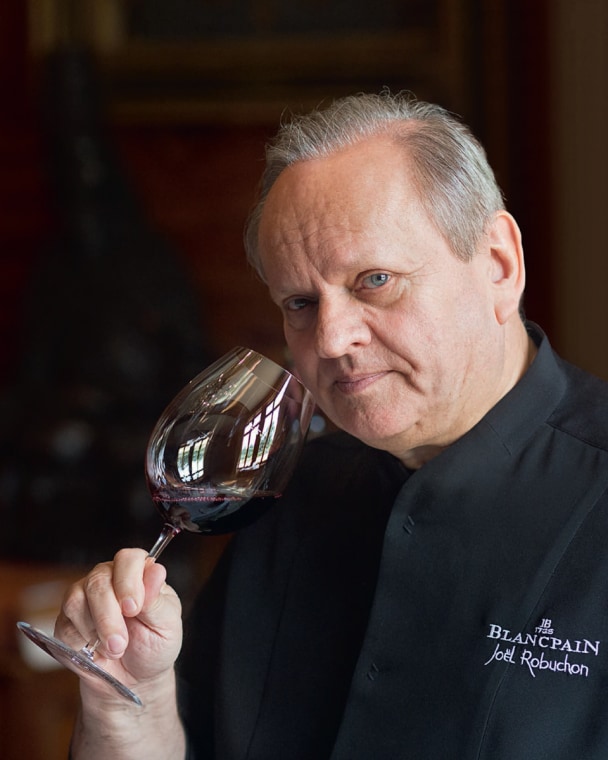
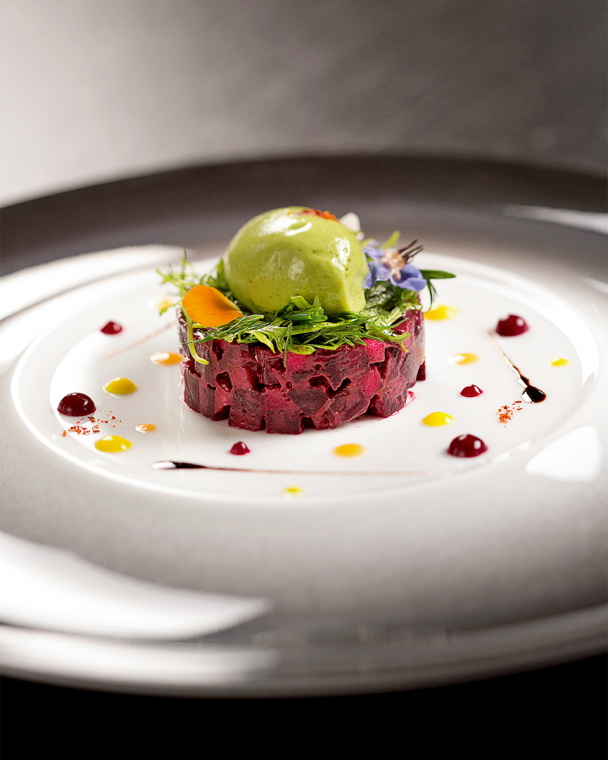
La betterave, en duo d’avocat, aux pousses de salades amères, sorbet à la moutarde verte.
Robuchon now has TWO STYLES of restaurants, the Ateliers and the grand restaurants.
Robuchon arguably has had two careers. The first was completely conventional, culminating with his 1984 garnering of three stars for his intimate restaurant Jamin located in Paris’ chic 16th arrondissement. “Conventional”, that is, if you consider that he rose to that lofty perch in but three years and at the age of 39, both records in the history of Michelin ratings. With his characteristic humility, Robuchon remarking at the time over his twin records—fastest to three stars and youngest chef so recognized—noted, “Receiving three stars does not mean I am worth it—it only means I have the right to prove it.” Ten years later, he moved to larger quarters on Avenue Raymond-Poincaré in Paris, changing the name of the restaurant to “Joël Robuchon”.
He was not to stay long on Raymond-Poincaré. Two years later, in 1996, he closed. Asked about his decision coming at the then peak of his fame, Robuchon wistfully muses that until that point he was working so intensely, particularly in the winter months, that “he never got to see the snow in the Alps”.
Although he kept himself well occupied on French TV starring in Cuisinez comme un grand chef (Cook like a Grand Chef), he was largely removed from the restaurant world until 2003, when he began his second major career. Approached by his friends and colleagues pleading for him to re-exercise his talents in a restaurant, Robuchon was persuaded to re-enter that world supported with teams of grand chefs. He would not be permanently attached to any single restaurant on a daily basis as he had been in his first career, but would be the creative force and inspiration for the restaurants. Along with this new way of working, Robuchon designed an entirely new restaurant concept called L’Atelier de Joël Robuchon (The Joël Robuchon Workshop). Instead of the grand restaurant format which propelled him to stardom with Jamin and Joël Robuchon during the 1980s and 1990s, L’Atelier would offer more informal surroundings with open kitchens, relaxed service, and, most radically of all, counter seating. The cuisine, however, would feature many of the dishes that built his legend. Said another way, this format placed the food first, with ceremony largely removed.
The first two Atelier restaurants opened in 2003, one in Tokyo and the other just off Rue du Bac in the 7th arrondissement on Paris’ Left Bank. As he puts it, after he opened these first two, “he just kept going” so that since then, Atelier doors have welcomed foodies around the globe: a second location in Paris near the Étoile, London, Hong Kong, Taipei, Las Vegas, Singapore...
One constant, ROBUCHON’S DEVOTION TO HIS TEAM.
Having initially foresworn the grand restaurant style when he commenced this second chapter of his career, he has allowed for some exceptions. Robuchon refers to these in conversation as “gastronomic” and presides over them in Las Vegas, Tokyo, Macau, Hong Kong and, the most recent addition, La Grande Maison in Bordeaux.
Naturally the question presents itself: how can he possibly preside over an empire this imposing and geographically dispersed? The answer is fourfold. First, of course, he selects a chef for each with the talent and skill to master his recipes and the fortitude to lead the staff. Second, he has assembled a team of five, certainly beloved by the airlines, who travel permanently from city to city supervising and quality controlling each restaurant. Then, on top of all that, Robuchon himself travels incessantly to each of his locations, not only to ensure the excellence of each, but to assist in the selection of local providers.
There is, however, one constant that towers over all of the others, Robuchon’s bottomless devotion and loyalty to the key members of his team, which is steadfastly returned by them. Examples: Chef Éric Bouchenoire, “Un des Meilleurs Ouvriers de France” in his own right (a distinction that few chefs ever achieve which is always marked by a tricolor collar on the chef ’s blouson which only a “Meilleur Ouvrier” is entitled to wear) and seeking no time in the limelight for himself, has been at Robuchon’s side for over twenty years, or Philippe Braun whose association dates back to the Jamin era and who returned to rejoin Robuchon in 2003 as the second chapter began, or Tomonori Danzaki, now the chef at La Grande Maison in Bordeaux, who began his career with Robuchon in Tokyo and followed him to Las Vegas and Singapore.
Of course, there is a degree of flexibility among the outposts to account not only for local tastes, but even more importantly local ingredients. For example, whereas giblets and rabbit are both adored in France, there are so few partisans in the US that they are not included on the Las Vegas menus. What is replicated worldwide is Robuchon’s cooking philosophy. In the more than three decades that yours truly has been following his career (and yes, we were fortunate to have experienced Jamin in Paris in the late fall of 1983, just a few months before Michelin announced his third star), he has steadfastly hewn to the course of freshness, purity, intensity of flavor and absence of artifice. Some of his creations from Jamin endure; devotees would take to the streets with pickaxes and flaming torches if his famous and unrivaled purée de pommes de terre were to one day disappear from any menu. Yet, ever faithful to his credos, he continues to innovate; Filets de maquereaux grillés au curcuma et à la coriandre fraîche or a coconut tandoori sauce napping a saint-pierre that would not have been seen earlier in his career both made debuts on current cards.
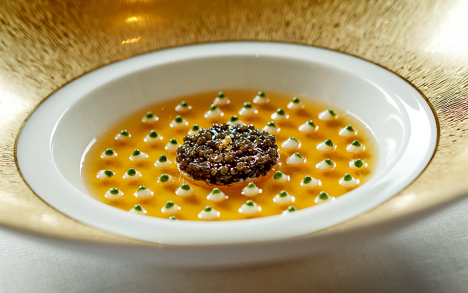
Caviar en surprise sur araignée de mer et une infusion de corail anisée.
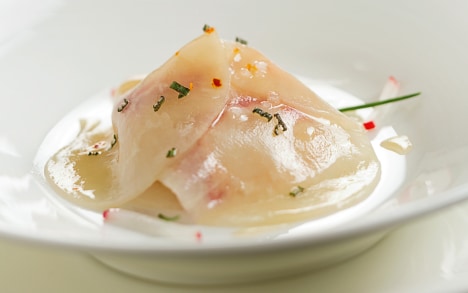
Le homard aux fines lamelles de daïkon en aigre-doux au romarin.
Robuchon’s Ateliers bring a MODERN VIBE.
L’Atelier de Joël Robuchon, Paris, 7th arrondissement
This Atelier pioneered the style and ambiance for those that have followed. The black color palate, punctuated by red leather stools and accents, an open kitchen, flanked by counters on three sides, waiters clad in black blouson set a contemporary vibe. Emphasizing the casual atmosphere, plates are served from the backside of the counter in front of each guest rather than, as tradition dictates, from the back of the diners, and, if shared, are placed on a facing upper level of the counter. With the distance barriers of separate tables removed, conversations among groups and, yes, leers at plates “next door” spontaneously break out around the room. If you are inclined to think of this as somewhat of a shared foodie community or, perhaps, a western interpretation of the ambiance of a Japanese sushi bar, you would not be too far off the mark.
Today, Robuchon has installed young chef Axel Manes to lead the Left Bank brigade.
A recent visit began with glasses of champagne served with a platter of nearly transparent beef carpaccio finished with a sheen of delicate olive oil. Visually and sensually it masqueraded as a plate of Iberian ham, but vastly more subtle and understated. Spice was served alongside with a plate of ethereally light and crisp green pepper tempura with piment d’Espelette.
Sharing continued as a first course of ceviche de dorade. Accented with chives, lime juice and zest, and punctuated with piment d’Espelette, it hit the bull’s-eye of rusticity and refinement at the same time. Magically, each bite vaporized on the palate without a trace of the mushiness that sadly infects lesser ceviches.
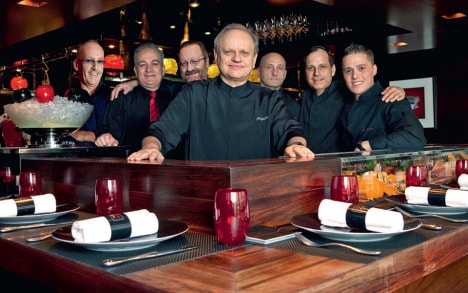
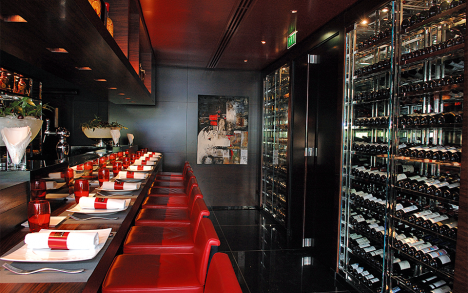
The Atelier in Paris’ 7th arrondissement.
Atmosphere informal, SOPHISTICATION ON THE PLATE.
Individual plates followed. First was Asperges vertes de Cavaillon, jambon ibérique, parmesan, sauce mousseline. This was an utterly classic pairing executed with millimetric precision and sparklingly magnificent ingredients. Riveting with the smokiness of the ham offsetting the sweet asparagus, it offered vivid proof of the virtues of exquisitely selected ingredients, simple preparation without artifice, and perfection in all details of execution.
As it was spring, morels were the next to take the stage with Cannelloni végétaux, sauce au vin jaune. These were cannelloni with a farce of celery root and morels. The pasta and celery root were perfect foils for the morels, propelling the earthiness forward.
Saint-pierre followed with an iridescent coconut tandoori infused sauce. There is always a bit of contradiction in the conception of a saint-pierre dish. On the one hand, the delicately flavored fish begs for an assertive sauce to bring it interest, but, on the other hand, not one that will completely mask it. Again, Robuchon found the balance. Tandoori, that can overwhelm if done without deftness, instead was there to bring a smoky highlight to seared white fish.
The meat course was grilled beef served with a rich red wine glace de viande sauce and shallot foam. It was the shallot foam that elevated this classic preparation above the usual genre.
High theater marked the principal dessert. The service plate was a trompe-l’œil with a photo of two hands appearing to bear the glass globe poised upon it. The glass globe was a cornucopia of different chocolate savors and textures: chocolate passion fruit/raspberry crisp, malt balls, salty chocolate powder, chocolate mousse. This was a work of genius. Counsel was given to eat these different declinations of chocolate together. Magic.
One last surprise awaited. Petits-fours included small wedges of tarte vaudoise. This is a classic Swiss tart, rarely seen outside of the country, that hails from Blancpain’s home Canton de Vaud. It features a highly reduced cream filling flavored with cinnamon. Robuchon’s execution was perfect.
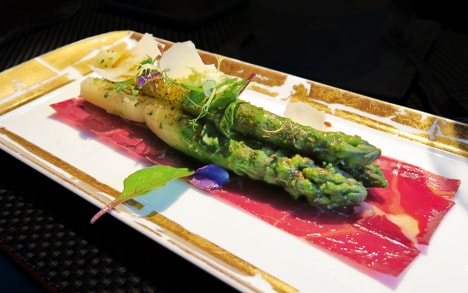
Asperges vertes de Cavaillon, jambon ibérique, parmesan, sauce mousseline.
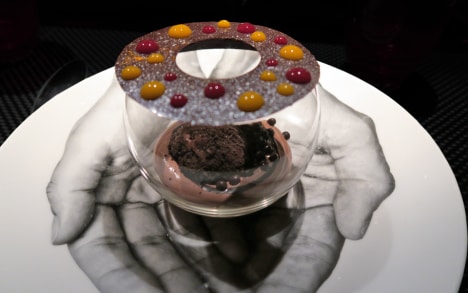
Le chocolat tentation.
La Grande Maison, Bordeaux
This newest gastronomic restaurant opened in December 2014. Almost immediately it has become a sensation, with overflowing reservation books requiring two months advance reservation to secure a coveted place. Set within a lovingly restored former residence, its luxuriously separated tables, high ceilings, floral drapes, Baccarat crystal chandeliers, gilt framed mirrors, and, in another room, bookshelf lined walls with leather bound volumes, all breathe classic French grandeur.
Both a preset tasting menu or individually composed menus chosen from the card are offered.
One of Robuchon’s grand classics heralds the start of the tasting menu parade, Caviar en surprise sur araignée de mer et une infusion de corail anisée. Here Robuchon poised a generous disk of caviar d’Aquitaine completely concealing delicate spider crab beneath. Surrounding the disk was nothing less than a mesmerizing work of modern art. Upon an intensely flavored bed of gelée of crab were miniature dots of cauliflower, each decorated with a nearly microscopic green dot. It seemed tragic, spoon poised above, to destroy the composition. But destroy we did and with gusto. Different dimensions of this preparation’s perfection emerge with every spoonful: the interplay of the sweet crab with the salty caviar, the depth and remarkable power of the gelée, the subtle earthiness of the cauliflower dots. Even with an armada of following plates waiting in the wings, the temptation was to terminate the proceedings at that point and indulge in several replenishments.
A paradox: why is it that notwithstanding Herculean the efforts expended to find boutique farms growing sparklingly perfect produce, the grander the restaurant, the fewer the vegetables evidenced on the plates? Garnishes, yes. Accents, yes. But center pieces, increasingly rare. Robuchon is not of that school.
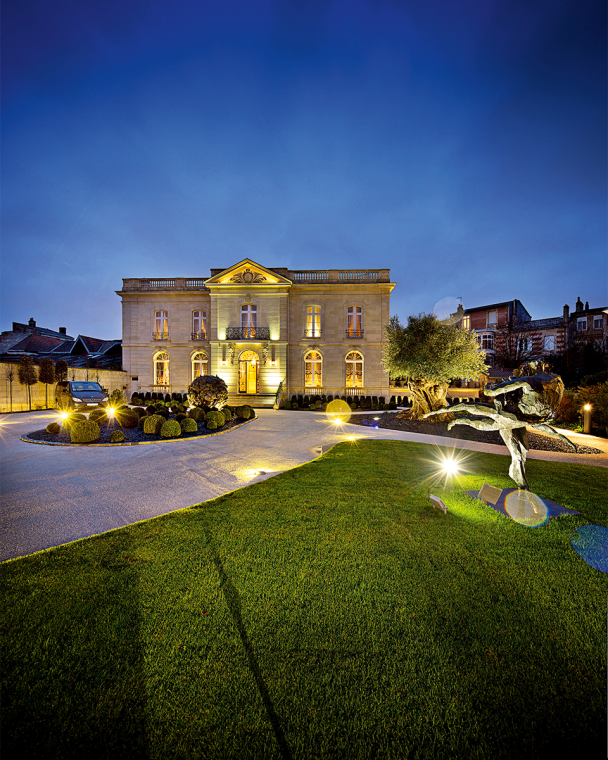
La Grande Maison.
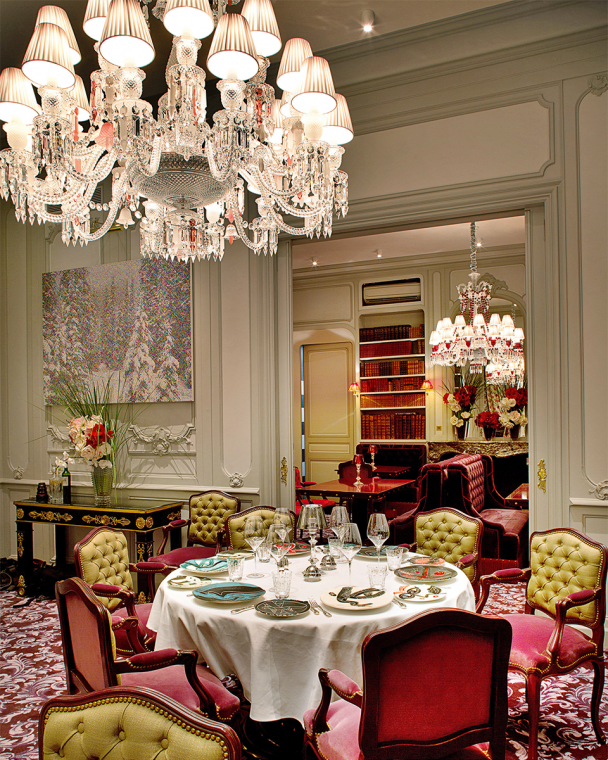
La Grande Maison BREATHES FRENCH GRANDEUR.
La Grande Maison proposes several plates with vegetables squarely in the limelight. Examples: La betterave, en duo d’avocat, aux pousses de salades amères, sorbet à la moutarde verte. Balanced, subtle and harmonious, each forkful revealed an intriguing interplay between sweet, earth, grass and spice. Equally show stopping, L’artichaut, rôti sur une purée onctueuse, voilé d’un cappuccino de pois chiches au curcuma et à la coriandre fraîche. Roasting concentrated and sweetened the sections of artichoke heart, all wrapped in the velvet of the purée. The chickpea foam, enrichened with abundant saffron and accented by the smoky curcuma (a type of turmeric), deepened and ennobled the plate.
Two shellfish preparations were standouts. Le homard aux fines lamelles de daïkon en aigre-doux au romarin. The appearance of the cooked, until just translucent lobster, sheathed in transparent daikon was of a raviolo. Plainly marinated, the daikon lent sweet notes harmonizing with the lobster, both bathed in a shell stock based sauce. Les écrevisses dans un bouillon léger aux morilles dans un navet nouveau farci. Crayfish are delicate and too often overwhelmed in their pairings.
Robuchon steered clear of this peril with a crayfish bouillon hinting of the morels and whipped into a foam. Rather than obscured, fragile flavors were concentrated. The sweet turnip served as the bowl to hold it all and offered a sweet counterpoint. Perfect.
A nod toward the Far East with Le bar de ligne cuit en côtelette, petites feuilles d’épinards ravigotées au poivre noir de Malabar. Formed into a cylinder, wrapped in its naturally black and crispy skin, the appearance was not unlike a sushi roll, the thought not dispelled at all with a leaf of baby bok choy poised as a sail atop. The eastern flair continued with the deep rich sauce redolent of soy and bringing slightly sweet and smoky notes.
A SHOW STOPPER main course.
The main course was a show stopper. Pintade fermière et foie gras rôti, pommes de terre confites au jus gras. The perfectly bronzed glistening guinea fowl, regal in size, was presented then carved tableside. In every single dimension this guinea fowl defined the genre. Crackling skin, rich savory meat offering just enough chew to show that, far from being caged, this bird had been given abundant freedom to roam, laced with a concentrated jus and served with a generous portion of roasted foie gras, here was a dish to inspire revelry for devotees of game. And, so as not to disappoint Robuchon followers, both roast potatoes and his legendary purée were served alongside.
La Grande Maison revives one of the past glories of fine dining, a dessert trolley groaning with seasonal fruits, tarts, chocolates and mousses. Guests are invited to chose as their hearts and appetites allow. From the cart, a recent spring offering of a strawberry-rhubarb tart with a thin layer of pistachio between the fruit and the pastry was a reference point for the genre. Desserts are offered on the menu as well such as Le citron, crème légère au mascarpone, sorbet au basilic packing an astonishing punch of citrus de Menton flavor, moderated by the mascarpone but followed by an explosion of spice from the sorbet. Another standout, La perle de sucre aux fruits exotiques, granité Royal Ambré, légèreté à la noix de coco which featured a featherlight ensemble of passion fruit, rum granita, and a cloud like coconut mousse, all meant to be eaten together in each spoonful.
In many ways, Robuchon is the Mick Jagger of grand cuisine. As Jagger, at the age of 72, improbably still seems at the peak of his powers, Robuchon’s energy and creativity seem inexhaustible. It would be a remarkable achievement to have created two different styles of restaurants of the quality of his Ateliers and gastronomic houses next door to each other in the same city. It is astonishing to do so across the globe all the while accumulating verdicts of stars and unwavering acclaim from the most discriminating of all inspectors, those from the Guide Michelin.
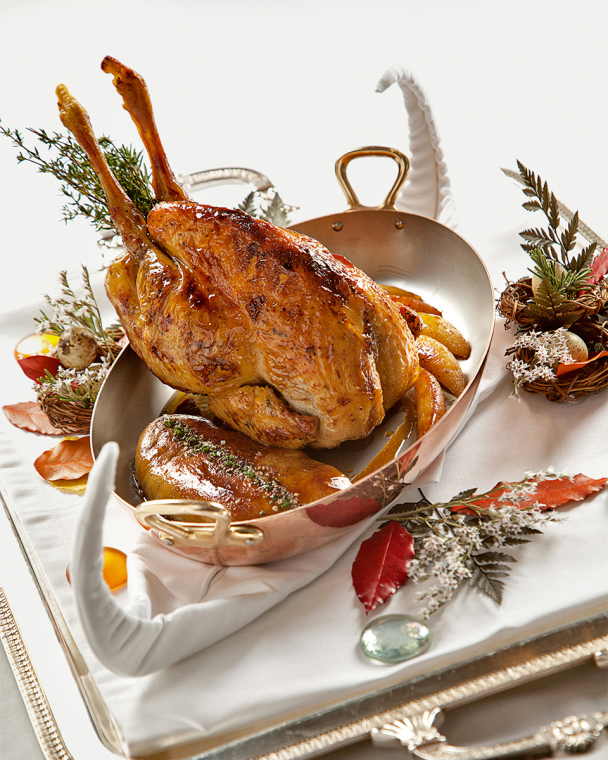
Pintade fermière et foie gras rôti, pommes de terre confites au jus gras.
Other issues
Don't miss the latest issue
Sign Up for New Releases






